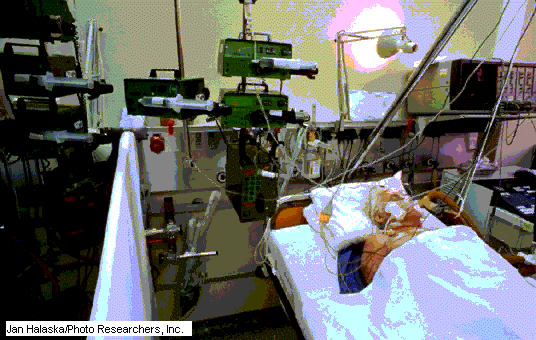
One of the biggest controversies of this decade is euthanasia. Euthanasia is “inducing the painless death of a person for reasons assumed to be merciful?(Henrickson and Martin 24). There are four types of euthanasia voluntary and direct, voluntary but indirect, direct but involuntary, and indirect and involuntary. Voluntary and direct euthanasia is “chosen and carried out by the patient.? Voluntary but indirect euthanasia is chosen in advance. Direct but involuntary euthanasia is done for the patient without his or her request. Indirect and involuntary euthanasia occurs when a hospital decides that it is time to remove life support (Fletcher 42-3).
Euthanasia can be traced as far back as to the ancient Greek and Roman civilizations. It was sometimes allowed in these civilizations to help others die. Voluntary euthanasia was approved in these ancient societies. As time passed, religion increased, and life was viewed to be sacred. Euthanasia in any form was seen as wrong (Encarta 98).
In this century there have been many groups formed that are for and against euthanasia. In 1935 the first group that was for the legalization of euthanasia was formed. It was called the Voluntary Euthanasia Society and was started by a group of doctors in London (The Voluntary Euthanasia Society). The first society established in the United States came shortly after in 1938. It was called the Hemlock Society and it now consists of more than 67,000 members. The purpose of this society is to support your decision to die and to offer support when you are ready to die (Humphrey 186). This society also believes that a person must have believed in euthanasia for a certain amount of time before you can make the request for death (Humphrey 112).
Euthanasia has been a large issue in the courts during this century. The first doctor was charged for performing euthanasia in1935. Harold Blazer was charged for the death of his daughter. His daughter was a victim of cerebral spinal meningitis. He killed her by placing a handkerchief soaked with chloroform over her face until she died. He had taken care of her for thirty years. In his trial he was acquitted (Humphrey 191). The first doctor to be found guilty was Joseph Hassman in 1986. He injected a lethal dose of Demerol into his mother-in-law by the request of her family. He was sentenced to two years probation, fined $10,000, and ordered to perform 400 hours of community service (Humphrey 194).
The most recent and most controversial euthanasia doctor is Dr. Jack Kevorkian. He was first charged with first degree murder in December of 1990. He connected Janet Adkins, a member of the Hemlock Society, to his “suicide machine?which allowed her to inject lethal drugs into her body at any time (Humphrey 195-96) . He has since then been present at the deaths of more than forty people (Euthanasia Research and Guidance Organization).
A number of legal considerations are involved in the issue of euthanasia. The state has the right to become very involved in euthanasia cases. The state can specify the number of individuals that must agree for euthanasia to be performed. The state can specify how frequently someone can sign a euthanasia authorization. The state can also specify that only the individual can decide (Pahl 20).
Living wills are also a big part in the legal aspects of euthanasia. A living will can express a patient’s thoughts towards his future medical treatment (Horkan 70). Living wills are legal in forty states. They allow anyone capable of making decisions to tell the doctor beforehand that they do not wish to be put on life support (Encarta 98).
The medical methods and effects have a large impact on how people view euthanasia. Euthanasia can be performed by lethal injection, gas, the removal of life support equipment, the withholding of food and fluids, and the removal of necessary medicines. It is legal to turn off a patient’s life support when the higher centers of the brain stop working. Patients are allowed to choose passive euthanasia but can not choose active euthanasia. Passive euthanasia is when nothing is done to prevent death. Active euthanasia is when one deliberately causes death (Encarta 98). One of the main forms of euthanasia is the process of withholding foods and fluids. Many see this as cruelty due to its effects on the patient. It causes nausea, vomiting, heart problems, depression, dry skin, and shortness in breath (Harris 5). As one can see there are many aspects and issues that make euthanasia controversial.
Since I have provided you with this helpful information please help me by visiting my links:
Where To Put Your Plasma TV | Rules of Kitchen Design | Bathroom Remodeling